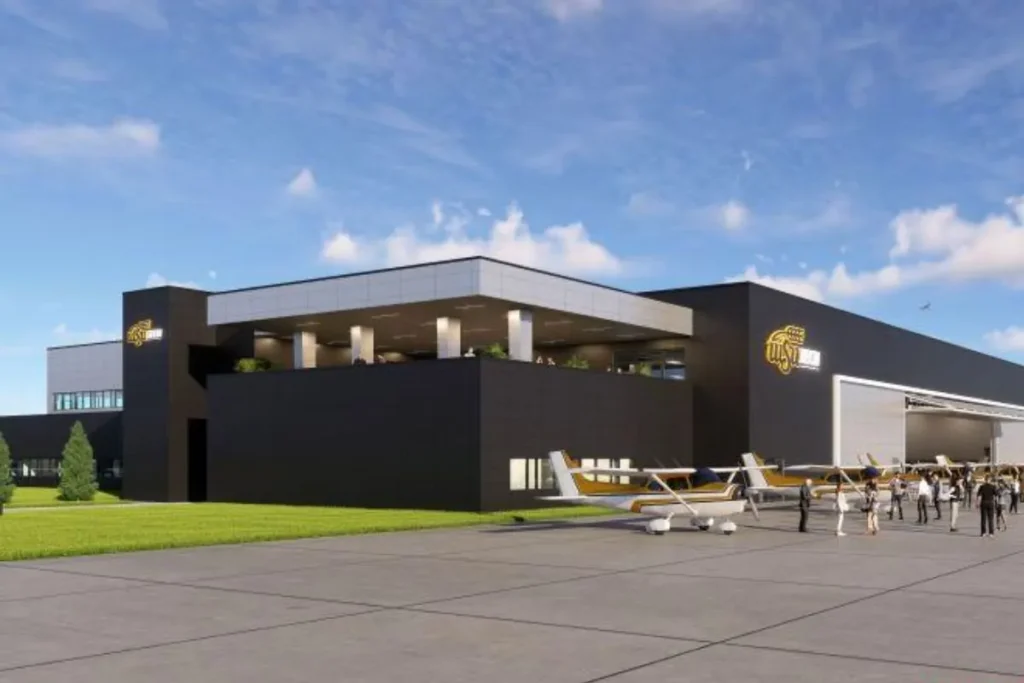Wichita, Kansas, will soon have more resources for training present and future aviation technical workers, including technicians, pilots, and personnel in fields such as advanced air mobility and manufacturing.
WSU Tech is investing $45 million to expand its National Center for Aviation Training (NCAT) in response to the growing demand for qualified workers. The school claims that the completed expansion, scheduled for completion in January 2027, will enable it to accommodate 1,450 additional students and trainees within the first three years.
The expansion will entail the construction of a new 85,500-square-foot facility at Colonel James Jabara Airport, which will house additional classrooms, lab space, and a hangar dedicated to pilot training.
WSU Tech Adds New Hangar, Pilot Facilities, and Simulators
WSU Tech’s VP of aviation and workforce development, James Hall, tells Aviation Week Network that the school’s aviation program has been limited in space since it began its pilot training program three years ago, thus many of the school’s aircraft have had to be stored away.
“By establishing another 20,000 ft.2 hangar, we will be able to relocate our pilot program to its dedicated area. [The program will] have more simulator rooms, more prep rooms, and continue to prioritize having a high-quality flight program,” he says, stressing that WSU Tech’s pilot training is geared toward professional pilots rather than hobbyists.
The expansion will also allow WSU Tech to nearly double the capacity of its popular high school aviation maintenance technology academy, which allows high school students to complete the FAA airframe and powerplant (A&P) curriculum before graduation, allowing them to obtain both a high school diploma and A&P licenses at the same time, all funded by the state. Hall reports that the program, which has been in operation since 2016, presently has a sizable wait list. WSU Tech conducts the high school academy in addition to providing the Choose Aerospace curriculum to various area high schools.
“I often look at the ATEC Pipeline report and the Boeing [Pilot and Technician Outlook], and we talk about what the needs are for aviation mechanics and how we can help fill those needs,” according to him. “We’re working closely with all of our employers to attempt to do that. My pupils all leave with their A&P certificates and jobs since they are in high demand in our area; even if I had another 200 students, I could find them work tomorrow.”
The NCAT’s expansion will also allow for growth in WSU Tech’s unmanned aircraft systems (UAS) department. According to Hall, the program benefits a variety of companies while also providing municipal training to police, fire, emergency, and rescue personnel. The UAS program is presently housed in a classroom and needs trainees to travel off-site for most activities, but Hall says the new classroom will have extra-high ceilings, allowing UAS to be flown indoors.
WSU Tech is also expanding its programs for advanced air mobility (AAM) and innovative manufacturing. The NCAT extension will contain a dedicated AAM lab and an innovation center with training capabilities in robotics, the Internet of Things, and smart industrial technology.
Beyond training new entrants into the aviation profession, WSU Tech claims the facility will serve as a hub for industry partners to train and upskill their current personnel. “We are seeing an increase in requests for one-off type trainings to help different agencies, whether they’re government or private, to upskill their employees,” Hall informs me. He describes the innovation lab as an “ideation space” where employers will be able to collaborate on new ideas and concepts.
Construction on the new facility is expected to begin on August 22.
Discover more valuable, real-time updates on Seonba.
Read aviation news updates, stories, and expert insights.

